Corporate Law Assignment: Business Structures and Employee Rights
VerifiedAdded on 2022/09/29
|13
|2410
|20
Report
AI Summary
This corporate law assignment solution addresses two key questions related to business structures and employee rights under Australian law. Question 1 examines the advantages and disadvantages of sole trader, partnership, and company structures for Penelope and Norman's growing arts and crafts business, recommending a proprietary company structure based on their specific needs of tax effectiveness, capital raising and limited liability. Question 2 focuses on Stanley's employment, analyzing whether he can prevent Nelson Electronics Ltd. from terminating his services as an accountant, considering the constitution of the company and relevant sections of the Corporations Act. The analysis explores the enforceability of the constitution, rights conferred to Stanley, and the implications of being a shareholder, providing a comprehensive legal argument and conclusions for each issue.
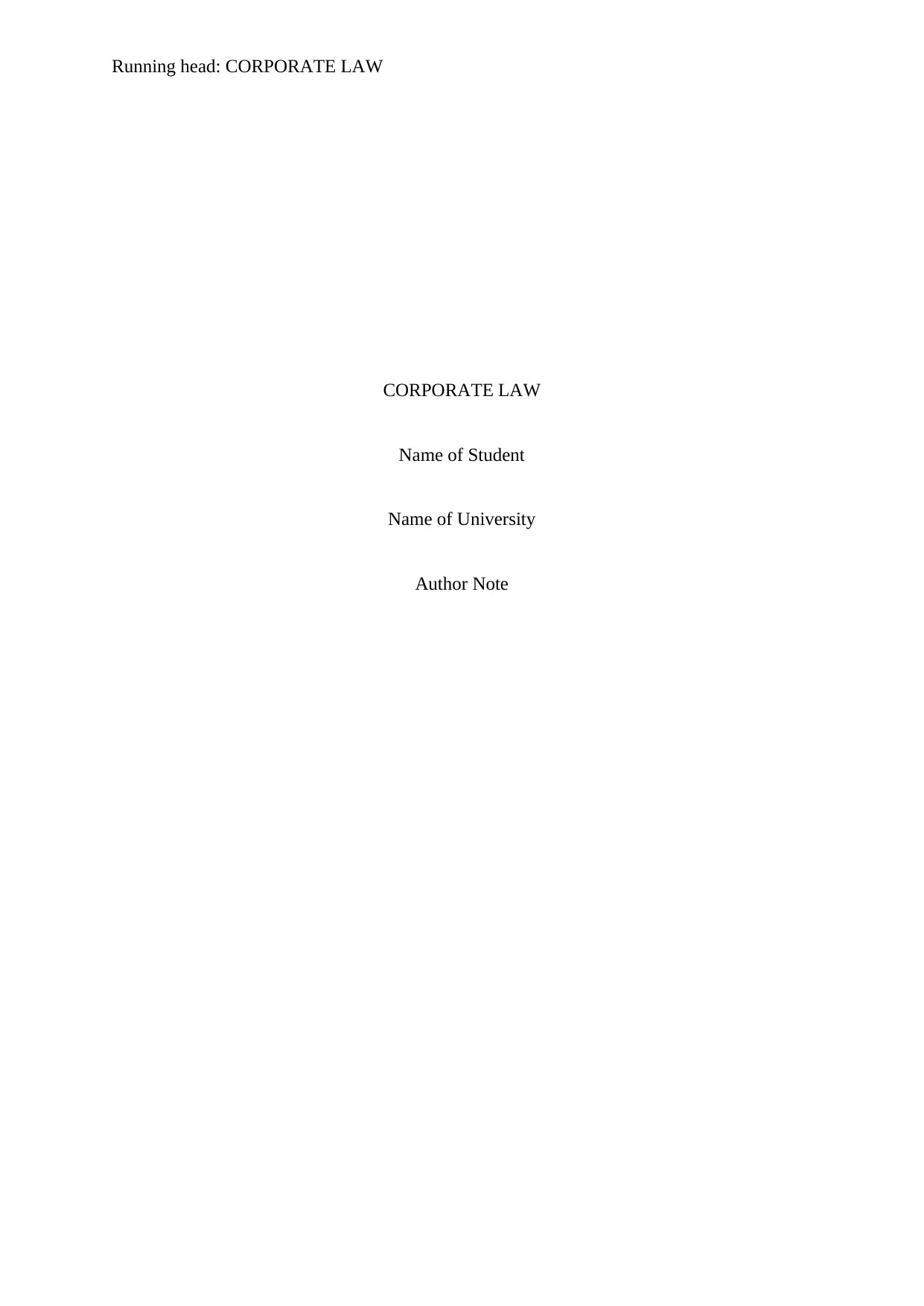
Running head: CORPORATE LAW
CORPORATE LAW
Name of Student
Name of University
Author Note
CORPORATE LAW
Name of Student
Name of University
Author Note
Paraphrase This Document
Need a fresh take? Get an instant paraphrase of this document with our AI Paraphraser
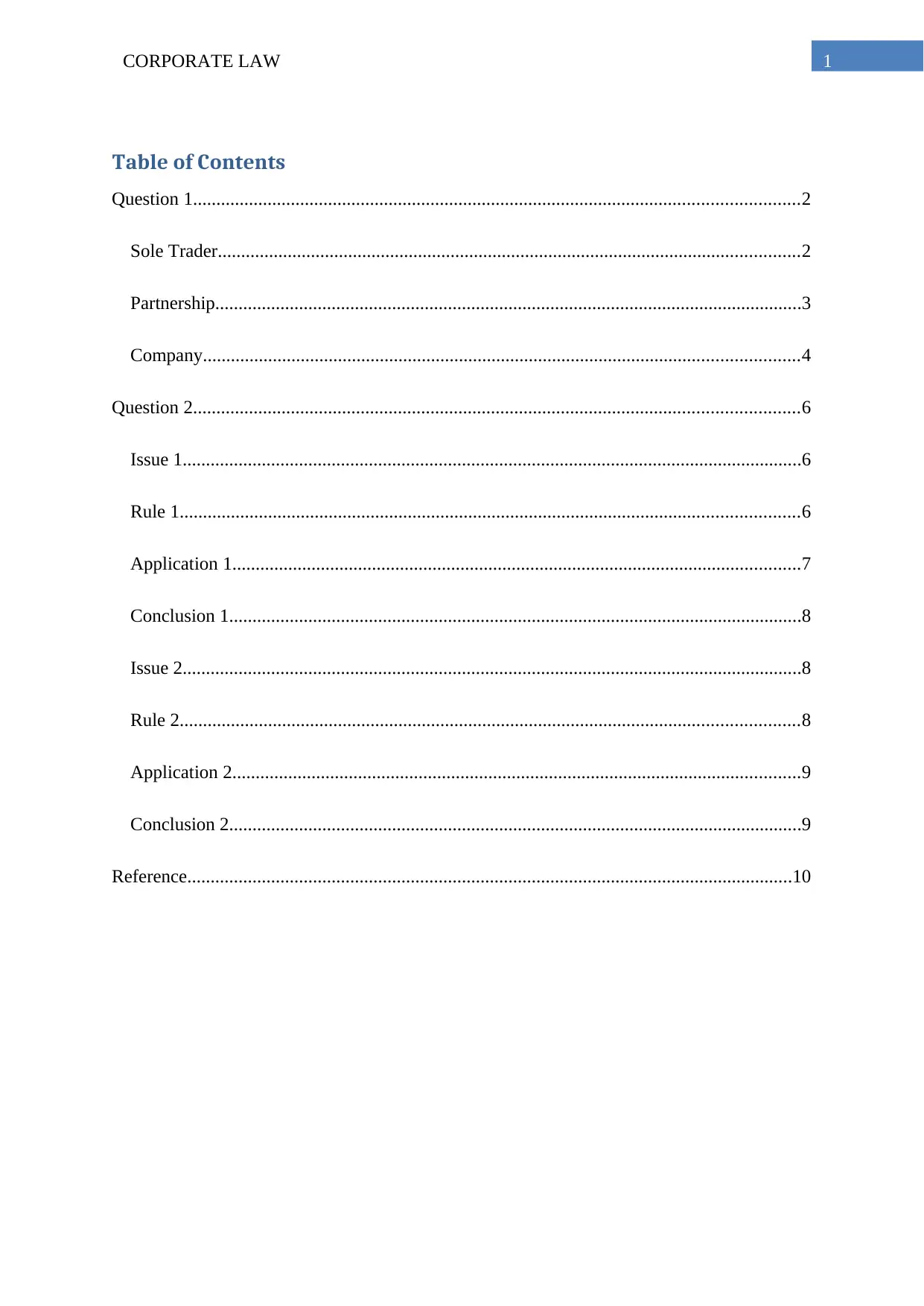
1CORPORATE LAW
Table of Contents
Question 1..................................................................................................................................2
Sole Trader.............................................................................................................................2
Partnership..............................................................................................................................3
Company................................................................................................................................4
Question 2..................................................................................................................................6
Issue 1.....................................................................................................................................6
Rule 1.....................................................................................................................................6
Application 1..........................................................................................................................7
Conclusion 1...........................................................................................................................8
Issue 2.....................................................................................................................................8
Rule 2.....................................................................................................................................8
Application 2..........................................................................................................................9
Conclusion 2...........................................................................................................................9
Reference..................................................................................................................................10
Table of Contents
Question 1..................................................................................................................................2
Sole Trader.............................................................................................................................2
Partnership..............................................................................................................................3
Company................................................................................................................................4
Question 2..................................................................................................................................6
Issue 1.....................................................................................................................................6
Rule 1.....................................................................................................................................6
Application 1..........................................................................................................................7
Conclusion 1...........................................................................................................................8
Issue 2.....................................................................................................................................8
Rule 2.....................................................................................................................................8
Application 2..........................................................................................................................9
Conclusion 2...........................................................................................................................9
Reference..................................................................................................................................10
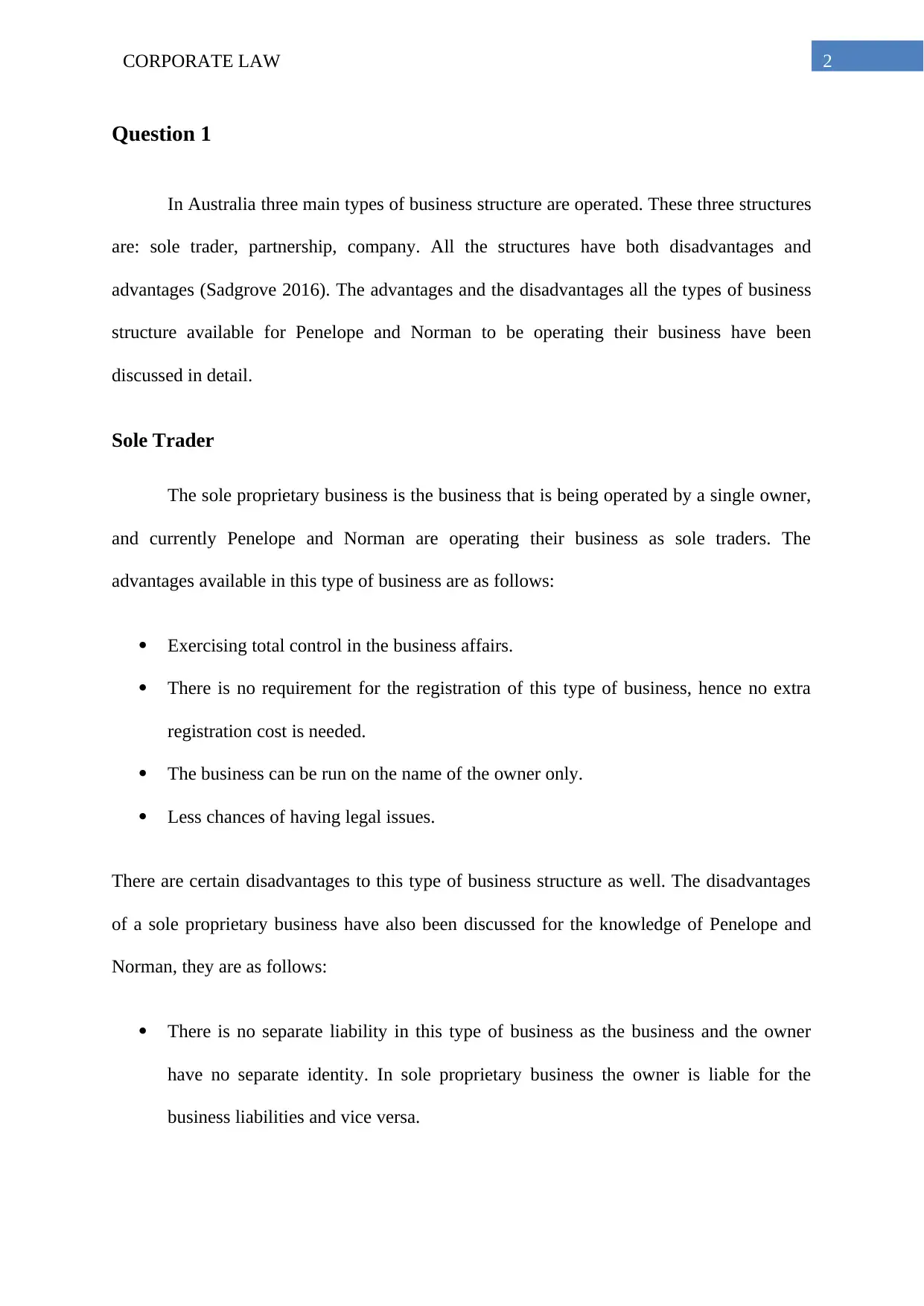
2CORPORATE LAW
Question 1
In Australia three main types of business structure are operated. These three structures
are: sole trader, partnership, company. All the structures have both disadvantages and
advantages (Sadgrove 2016). The advantages and the disadvantages all the types of business
structure available for Penelope and Norman to be operating their business have been
discussed in detail.
Sole Trader
The sole proprietary business is the business that is being operated by a single owner,
and currently Penelope and Norman are operating their business as sole traders. The
advantages available in this type of business are as follows:
Exercising total control in the business affairs.
There is no requirement for the registration of this type of business, hence no extra
registration cost is needed.
The business can be run on the name of the owner only.
Less chances of having legal issues.
There are certain disadvantages to this type of business structure as well. The disadvantages
of a sole proprietary business have also been discussed for the knowledge of Penelope and
Norman, they are as follows:
There is no separate liability in this type of business as the business and the owner
have no separate identity. In sole proprietary business the owner is liable for the
business liabilities and vice versa.
Question 1
In Australia three main types of business structure are operated. These three structures
are: sole trader, partnership, company. All the structures have both disadvantages and
advantages (Sadgrove 2016). The advantages and the disadvantages all the types of business
structure available for Penelope and Norman to be operating their business have been
discussed in detail.
Sole Trader
The sole proprietary business is the business that is being operated by a single owner,
and currently Penelope and Norman are operating their business as sole traders. The
advantages available in this type of business are as follows:
Exercising total control in the business affairs.
There is no requirement for the registration of this type of business, hence no extra
registration cost is needed.
The business can be run on the name of the owner only.
Less chances of having legal issues.
There are certain disadvantages to this type of business structure as well. The disadvantages
of a sole proprietary business have also been discussed for the knowledge of Penelope and
Norman, they are as follows:
There is no separate liability in this type of business as the business and the owner
have no separate identity. In sole proprietary business the owner is liable for the
business liabilities and vice versa.
⊘ This is a preview!⊘
Do you want full access?
Subscribe today to unlock all pages.

Trusted by 1+ million students worldwide
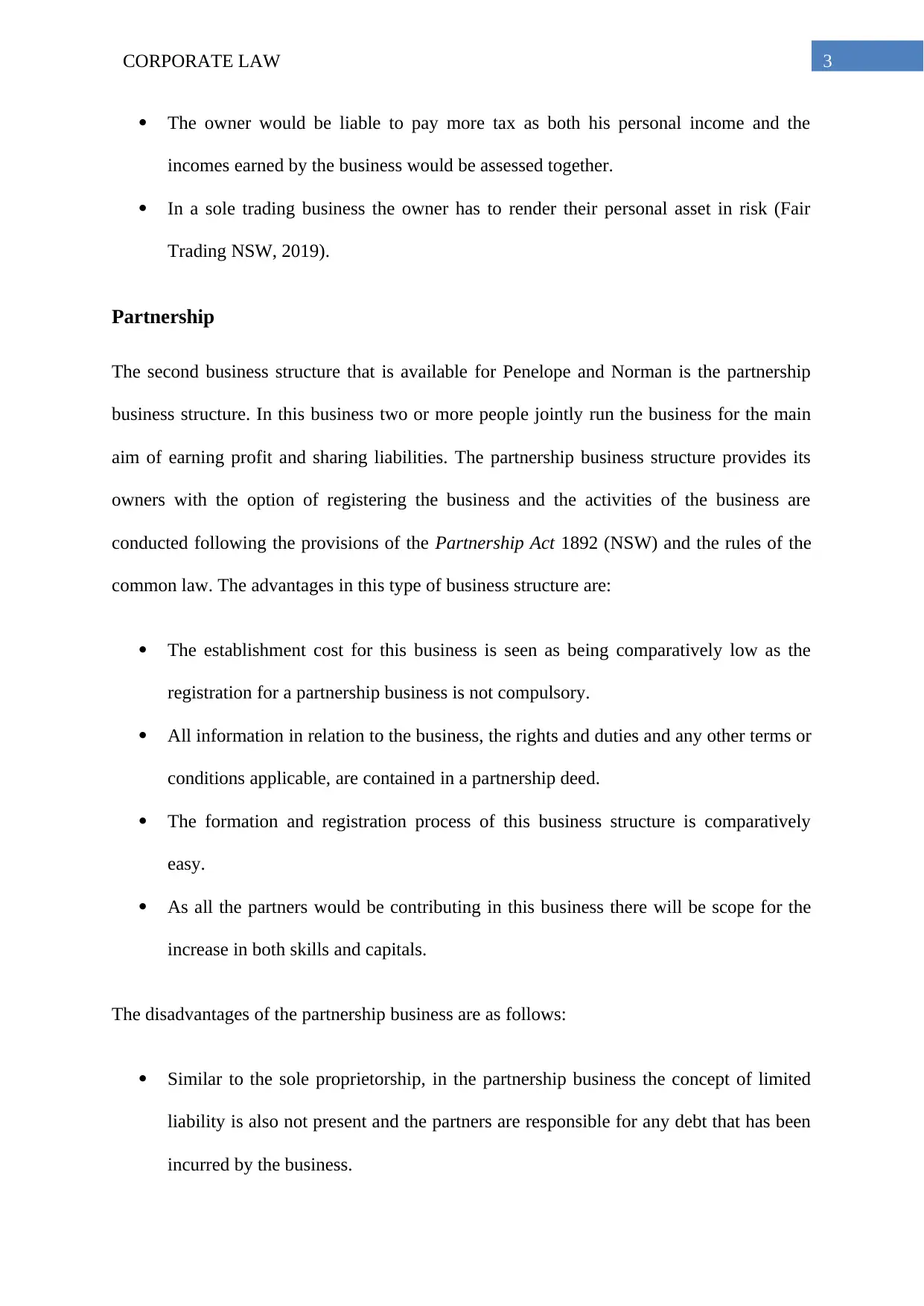
3CORPORATE LAW
The owner would be liable to pay more tax as both his personal income and the
incomes earned by the business would be assessed together.
In a sole trading business the owner has to render their personal asset in risk (Fair
Trading NSW, 2019).
Partnership
The second business structure that is available for Penelope and Norman is the partnership
business structure. In this business two or more people jointly run the business for the main
aim of earning profit and sharing liabilities. The partnership business structure provides its
owners with the option of registering the business and the activities of the business are
conducted following the provisions of the Partnership Act 1892 (NSW) and the rules of the
common law. The advantages in this type of business structure are:
The establishment cost for this business is seen as being comparatively low as the
registration for a partnership business is not compulsory.
All information in relation to the business, the rights and duties and any other terms or
conditions applicable, are contained in a partnership deed.
The formation and registration process of this business structure is comparatively
easy.
As all the partners would be contributing in this business there will be scope for the
increase in both skills and capitals.
The disadvantages of the partnership business are as follows:
Similar to the sole proprietorship, in the partnership business the concept of limited
liability is also not present and the partners are responsible for any debt that has been
incurred by the business.
The owner would be liable to pay more tax as both his personal income and the
incomes earned by the business would be assessed together.
In a sole trading business the owner has to render their personal asset in risk (Fair
Trading NSW, 2019).
Partnership
The second business structure that is available for Penelope and Norman is the partnership
business structure. In this business two or more people jointly run the business for the main
aim of earning profit and sharing liabilities. The partnership business structure provides its
owners with the option of registering the business and the activities of the business are
conducted following the provisions of the Partnership Act 1892 (NSW) and the rules of the
common law. The advantages in this type of business structure are:
The establishment cost for this business is seen as being comparatively low as the
registration for a partnership business is not compulsory.
All information in relation to the business, the rights and duties and any other terms or
conditions applicable, are contained in a partnership deed.
The formation and registration process of this business structure is comparatively
easy.
As all the partners would be contributing in this business there will be scope for the
increase in both skills and capitals.
The disadvantages of the partnership business are as follows:
Similar to the sole proprietorship, in the partnership business the concept of limited
liability is also not present and the partners are responsible for any debt that has been
incurred by the business.
Paraphrase This Document
Need a fresh take? Get an instant paraphrase of this document with our AI Paraphraser
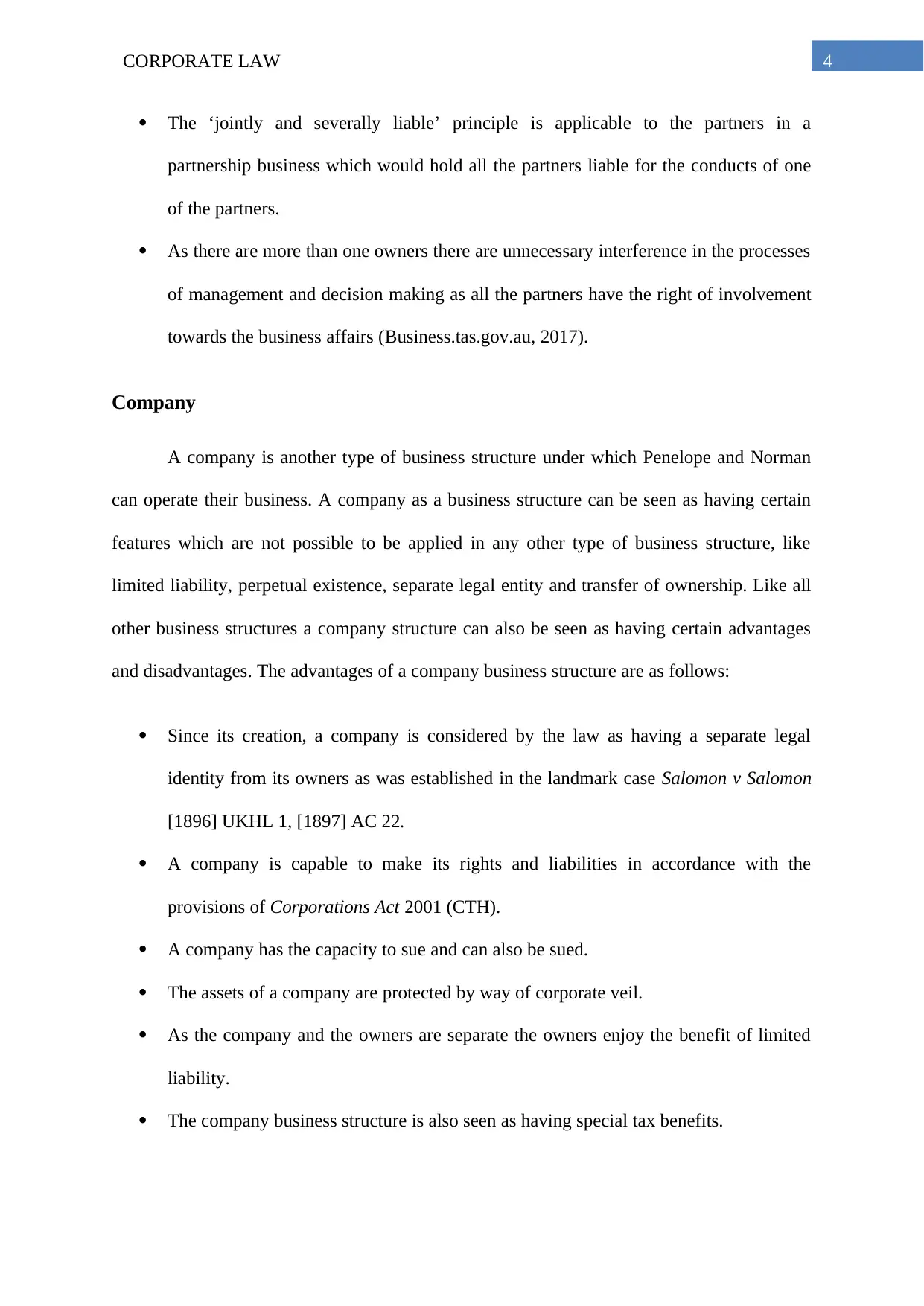
4CORPORATE LAW
The ‘jointly and severally liable’ principle is applicable to the partners in a
partnership business which would hold all the partners liable for the conducts of one
of the partners.
As there are more than one owners there are unnecessary interference in the processes
of management and decision making as all the partners have the right of involvement
towards the business affairs (Business.tas.gov.au, 2017).
Company
A company is another type of business structure under which Penelope and Norman
can operate their business. A company as a business structure can be seen as having certain
features which are not possible to be applied in any other type of business structure, like
limited liability, perpetual existence, separate legal entity and transfer of ownership. Like all
other business structures a company structure can also be seen as having certain advantages
and disadvantages. The advantages of a company business structure are as follows:
Since its creation, a company is considered by the law as having a separate legal
identity from its owners as was established in the landmark case Salomon v Salomon
[1896] UKHL 1, [1897] AC 22.
A company is capable to make its rights and liabilities in accordance with the
provisions of Corporations Act 2001 (CTH).
A company has the capacity to sue and can also be sued.
The assets of a company are protected by way of corporate veil.
As the company and the owners are separate the owners enjoy the benefit of limited
liability.
The company business structure is also seen as having special tax benefits.
The ‘jointly and severally liable’ principle is applicable to the partners in a
partnership business which would hold all the partners liable for the conducts of one
of the partners.
As there are more than one owners there are unnecessary interference in the processes
of management and decision making as all the partners have the right of involvement
towards the business affairs (Business.tas.gov.au, 2017).
Company
A company is another type of business structure under which Penelope and Norman
can operate their business. A company as a business structure can be seen as having certain
features which are not possible to be applied in any other type of business structure, like
limited liability, perpetual existence, separate legal entity and transfer of ownership. Like all
other business structures a company structure can also be seen as having certain advantages
and disadvantages. The advantages of a company business structure are as follows:
Since its creation, a company is considered by the law as having a separate legal
identity from its owners as was established in the landmark case Salomon v Salomon
[1896] UKHL 1, [1897] AC 22.
A company is capable to make its rights and liabilities in accordance with the
provisions of Corporations Act 2001 (CTH).
A company has the capacity to sue and can also be sued.
The assets of a company are protected by way of corporate veil.
As the company and the owners are separate the owners enjoy the benefit of limited
liability.
The company business structure is also seen as having special tax benefits.
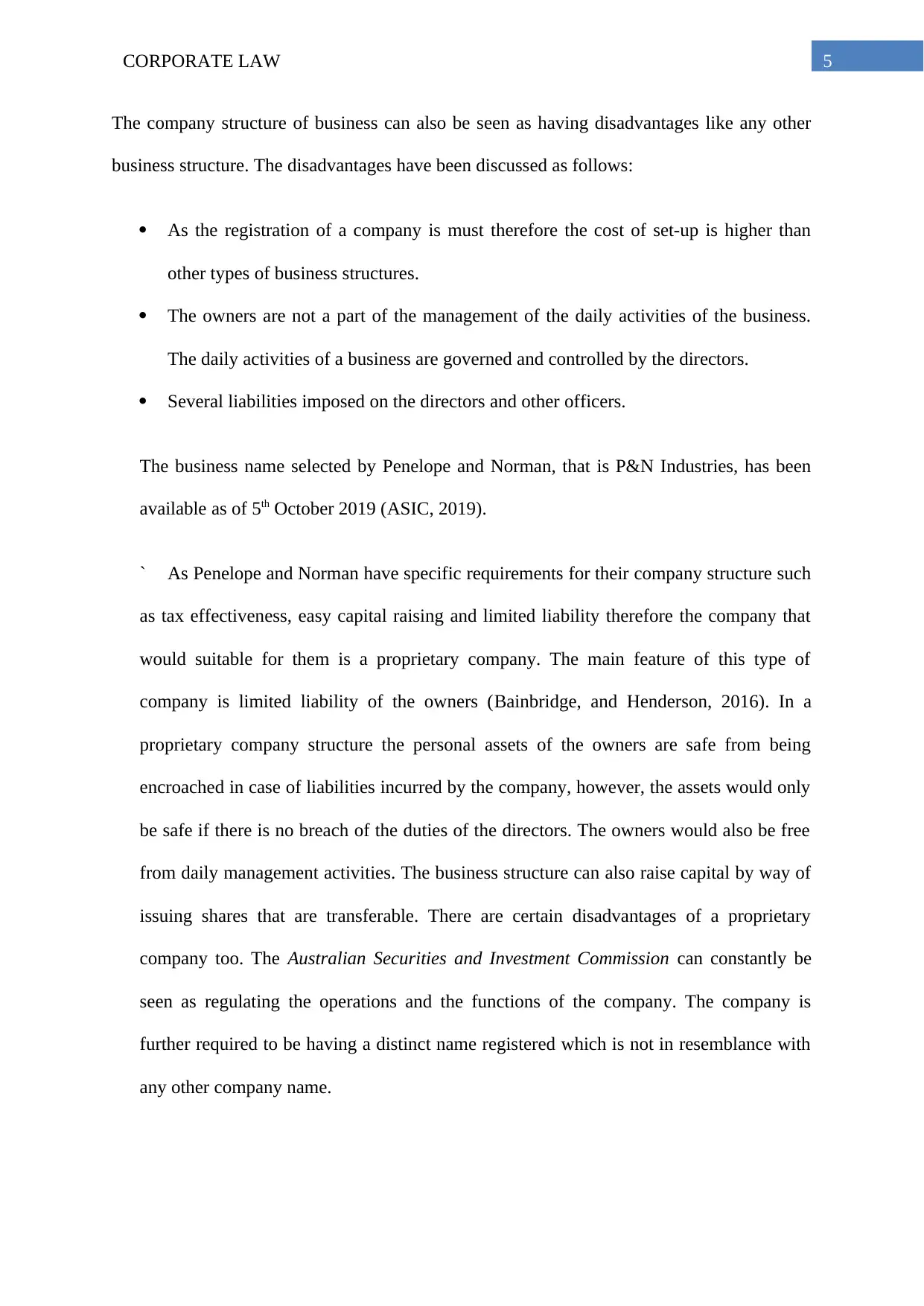
5CORPORATE LAW
The company structure of business can also be seen as having disadvantages like any other
business structure. The disadvantages have been discussed as follows:
As the registration of a company is must therefore the cost of set-up is higher than
other types of business structures.
The owners are not a part of the management of the daily activities of the business.
The daily activities of a business are governed and controlled by the directors.
Several liabilities imposed on the directors and other officers.
The business name selected by Penelope and Norman, that is P&N Industries, has been
available as of 5th October 2019 (ASIC, 2019).
` As Penelope and Norman have specific requirements for their company structure such
as tax effectiveness, easy capital raising and limited liability therefore the company that
would suitable for them is a proprietary company. The main feature of this type of
company is limited liability of the owners (Bainbridge, and Henderson, 2016). In a
proprietary company structure the personal assets of the owners are safe from being
encroached in case of liabilities incurred by the company, however, the assets would only
be safe if there is no breach of the duties of the directors. The owners would also be free
from daily management activities. The business structure can also raise capital by way of
issuing shares that are transferable. There are certain disadvantages of a proprietary
company too. The Australian Securities and Investment Commission can constantly be
seen as regulating the operations and the functions of the company. The company is
further required to be having a distinct name registered which is not in resemblance with
any other company name.
The company structure of business can also be seen as having disadvantages like any other
business structure. The disadvantages have been discussed as follows:
As the registration of a company is must therefore the cost of set-up is higher than
other types of business structures.
The owners are not a part of the management of the daily activities of the business.
The daily activities of a business are governed and controlled by the directors.
Several liabilities imposed on the directors and other officers.
The business name selected by Penelope and Norman, that is P&N Industries, has been
available as of 5th October 2019 (ASIC, 2019).
` As Penelope and Norman have specific requirements for their company structure such
as tax effectiveness, easy capital raising and limited liability therefore the company that
would suitable for them is a proprietary company. The main feature of this type of
company is limited liability of the owners (Bainbridge, and Henderson, 2016). In a
proprietary company structure the personal assets of the owners are safe from being
encroached in case of liabilities incurred by the company, however, the assets would only
be safe if there is no breach of the duties of the directors. The owners would also be free
from daily management activities. The business structure can also raise capital by way of
issuing shares that are transferable. There are certain disadvantages of a proprietary
company too. The Australian Securities and Investment Commission can constantly be
seen as regulating the operations and the functions of the company. The company is
further required to be having a distinct name registered which is not in resemblance with
any other company name.
⊘ This is a preview!⊘
Do you want full access?
Subscribe today to unlock all pages.

Trusted by 1+ million students worldwide
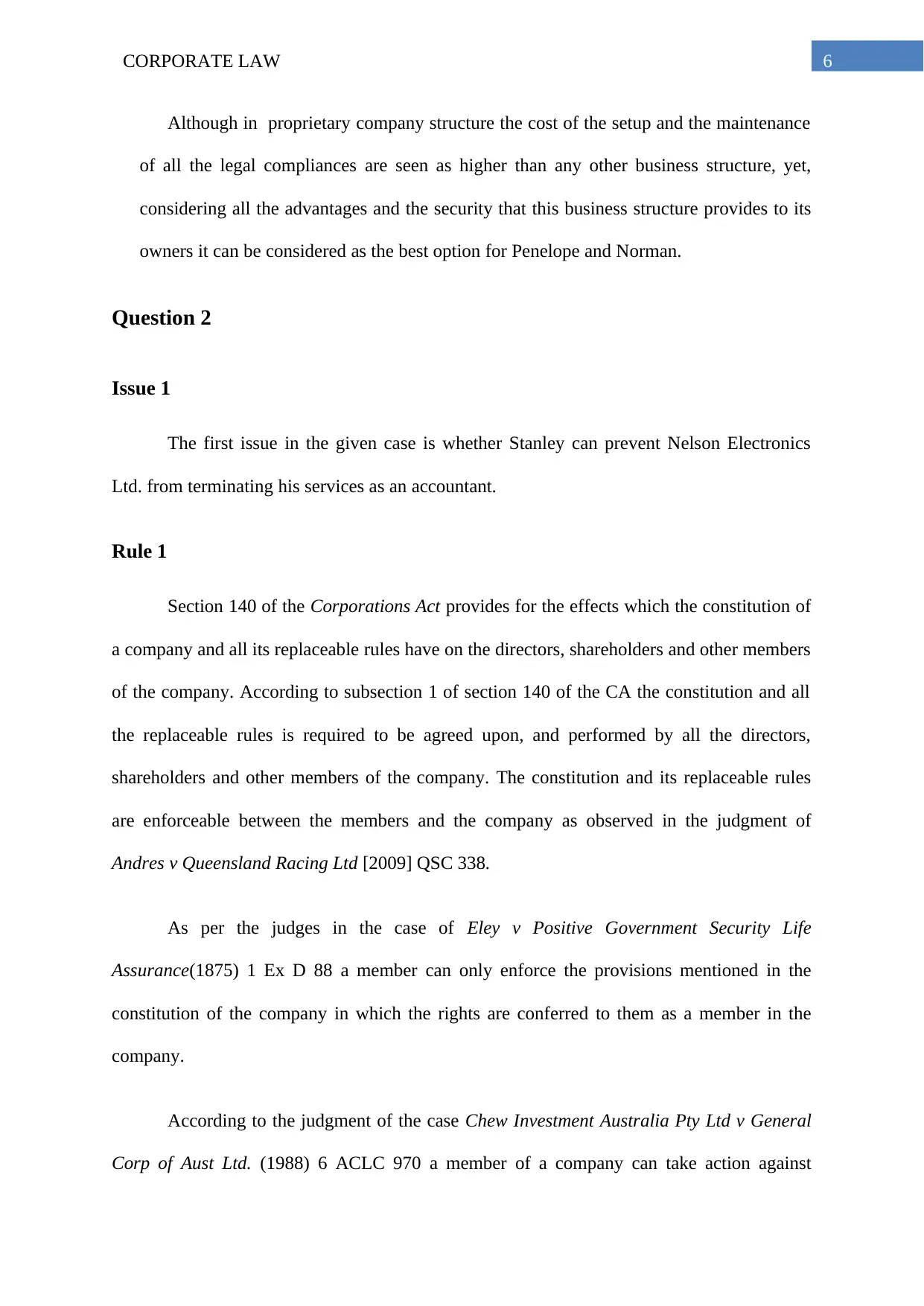
6CORPORATE LAW
Although in proprietary company structure the cost of the setup and the maintenance
of all the legal compliances are seen as higher than any other business structure, yet,
considering all the advantages and the security that this business structure provides to its
owners it can be considered as the best option for Penelope and Norman.
Question 2
Issue 1
The first issue in the given case is whether Stanley can prevent Nelson Electronics
Ltd. from terminating his services as an accountant.
Rule 1
Section 140 of the Corporations Act provides for the effects which the constitution of
a company and all its replaceable rules have on the directors, shareholders and other members
of the company. According to subsection 1 of section 140 of the CA the constitution and all
the replaceable rules is required to be agreed upon, and performed by all the directors,
shareholders and other members of the company. The constitution and its replaceable rules
are enforceable between the members and the company as observed in the judgment of
Andres v Queensland Racing Ltd [2009] QSC 338.
As per the judges in the case of Eley v Positive Government Security Life
Assurance(1875) 1 Ex D 88 a member can only enforce the provisions mentioned in the
constitution of the company in which the rights are conferred to them as a member in the
company.
According to the judgment of the case Chew Investment Australia Pty Ltd v General
Corp of Aust Ltd. (1988) 6 ACLC 970 a member of a company can take action against
Although in proprietary company structure the cost of the setup and the maintenance
of all the legal compliances are seen as higher than any other business structure, yet,
considering all the advantages and the security that this business structure provides to its
owners it can be considered as the best option for Penelope and Norman.
Question 2
Issue 1
The first issue in the given case is whether Stanley can prevent Nelson Electronics
Ltd. from terminating his services as an accountant.
Rule 1
Section 140 of the Corporations Act provides for the effects which the constitution of
a company and all its replaceable rules have on the directors, shareholders and other members
of the company. According to subsection 1 of section 140 of the CA the constitution and all
the replaceable rules is required to be agreed upon, and performed by all the directors,
shareholders and other members of the company. The constitution and its replaceable rules
are enforceable between the members and the company as observed in the judgment of
Andres v Queensland Racing Ltd [2009] QSC 338.
As per the judges in the case of Eley v Positive Government Security Life
Assurance(1875) 1 Ex D 88 a member can only enforce the provisions mentioned in the
constitution of the company in which the rights are conferred to them as a member in the
company.
According to the judgment of the case Chew Investment Australia Pty Ltd v General
Corp of Aust Ltd. (1988) 6 ACLC 970 a member of a company can take action against
Paraphrase This Document
Need a fresh take? Get an instant paraphrase of this document with our AI Paraphraser
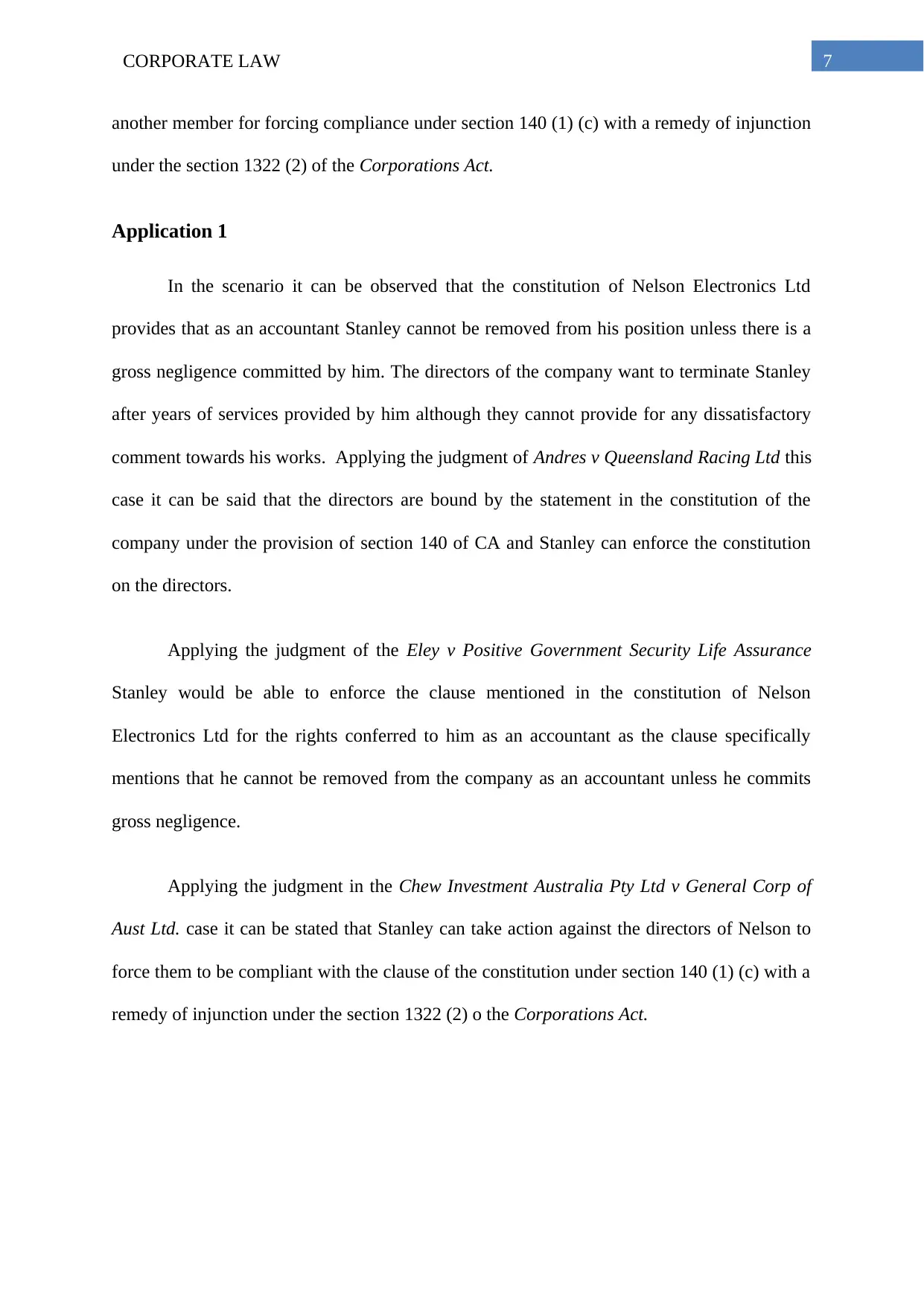
7CORPORATE LAW
another member for forcing compliance under section 140 (1) (c) with a remedy of injunction
under the section 1322 (2) of the Corporations Act.
Application 1
In the scenario it can be observed that the constitution of Nelson Electronics Ltd
provides that as an accountant Stanley cannot be removed from his position unless there is a
gross negligence committed by him. The directors of the company want to terminate Stanley
after years of services provided by him although they cannot provide for any dissatisfactory
comment towards his works. Applying the judgment of Andres v Queensland Racing Ltd this
case it can be said that the directors are bound by the statement in the constitution of the
company under the provision of section 140 of CA and Stanley can enforce the constitution
on the directors.
Applying the judgment of the Eley v Positive Government Security Life Assurance
Stanley would be able to enforce the clause mentioned in the constitution of Nelson
Electronics Ltd for the rights conferred to him as an accountant as the clause specifically
mentions that he cannot be removed from the company as an accountant unless he commits
gross negligence.
Applying the judgment in the Chew Investment Australia Pty Ltd v General Corp of
Aust Ltd. case it can be stated that Stanley can take action against the directors of Nelson to
force them to be compliant with the clause of the constitution under section 140 (1) (c) with a
remedy of injunction under the section 1322 (2) o the Corporations Act.
another member for forcing compliance under section 140 (1) (c) with a remedy of injunction
under the section 1322 (2) of the Corporations Act.
Application 1
In the scenario it can be observed that the constitution of Nelson Electronics Ltd
provides that as an accountant Stanley cannot be removed from his position unless there is a
gross negligence committed by him. The directors of the company want to terminate Stanley
after years of services provided by him although they cannot provide for any dissatisfactory
comment towards his works. Applying the judgment of Andres v Queensland Racing Ltd this
case it can be said that the directors are bound by the statement in the constitution of the
company under the provision of section 140 of CA and Stanley can enforce the constitution
on the directors.
Applying the judgment of the Eley v Positive Government Security Life Assurance
Stanley would be able to enforce the clause mentioned in the constitution of Nelson
Electronics Ltd for the rights conferred to him as an accountant as the clause specifically
mentions that he cannot be removed from the company as an accountant unless he commits
gross negligence.
Applying the judgment in the Chew Investment Australia Pty Ltd v General Corp of
Aust Ltd. case it can be stated that Stanley can take action against the directors of Nelson to
force them to be compliant with the clause of the constitution under section 140 (1) (c) with a
remedy of injunction under the section 1322 (2) o the Corporations Act.
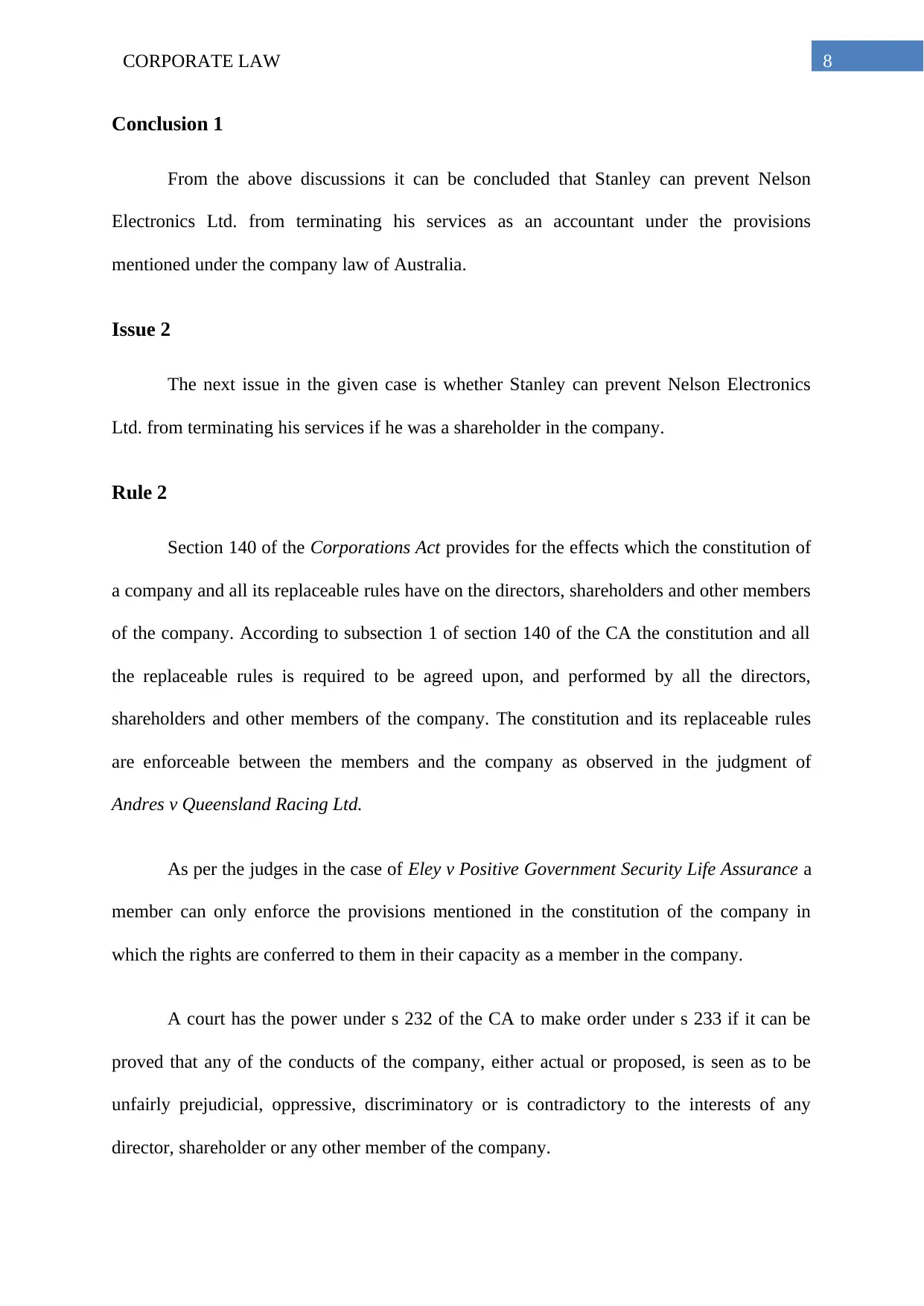
8CORPORATE LAW
Conclusion 1
From the above discussions it can be concluded that Stanley can prevent Nelson
Electronics Ltd. from terminating his services as an accountant under the provisions
mentioned under the company law of Australia.
Issue 2
The next issue in the given case is whether Stanley can prevent Nelson Electronics
Ltd. from terminating his services if he was a shareholder in the company.
Rule 2
Section 140 of the Corporations Act provides for the effects which the constitution of
a company and all its replaceable rules have on the directors, shareholders and other members
of the company. According to subsection 1 of section 140 of the CA the constitution and all
the replaceable rules is required to be agreed upon, and performed by all the directors,
shareholders and other members of the company. The constitution and its replaceable rules
are enforceable between the members and the company as observed in the judgment of
Andres v Queensland Racing Ltd.
As per the judges in the case of Eley v Positive Government Security Life Assurance a
member can only enforce the provisions mentioned in the constitution of the company in
which the rights are conferred to them in their capacity as a member in the company.
A court has the power under s 232 of the CA to make order under s 233 if it can be
proved that any of the conducts of the company, either actual or proposed, is seen as to be
unfairly prejudicial, oppressive, discriminatory or is contradictory to the interests of any
director, shareholder or any other member of the company.
Conclusion 1
From the above discussions it can be concluded that Stanley can prevent Nelson
Electronics Ltd. from terminating his services as an accountant under the provisions
mentioned under the company law of Australia.
Issue 2
The next issue in the given case is whether Stanley can prevent Nelson Electronics
Ltd. from terminating his services if he was a shareholder in the company.
Rule 2
Section 140 of the Corporations Act provides for the effects which the constitution of
a company and all its replaceable rules have on the directors, shareholders and other members
of the company. According to subsection 1 of section 140 of the CA the constitution and all
the replaceable rules is required to be agreed upon, and performed by all the directors,
shareholders and other members of the company. The constitution and its replaceable rules
are enforceable between the members and the company as observed in the judgment of
Andres v Queensland Racing Ltd.
As per the judges in the case of Eley v Positive Government Security Life Assurance a
member can only enforce the provisions mentioned in the constitution of the company in
which the rights are conferred to them in their capacity as a member in the company.
A court has the power under s 232 of the CA to make order under s 233 if it can be
proved that any of the conducts of the company, either actual or proposed, is seen as to be
unfairly prejudicial, oppressive, discriminatory or is contradictory to the interests of any
director, shareholder or any other member of the company.
⊘ This is a preview!⊘
Do you want full access?
Subscribe today to unlock all pages.

Trusted by 1+ million students worldwide
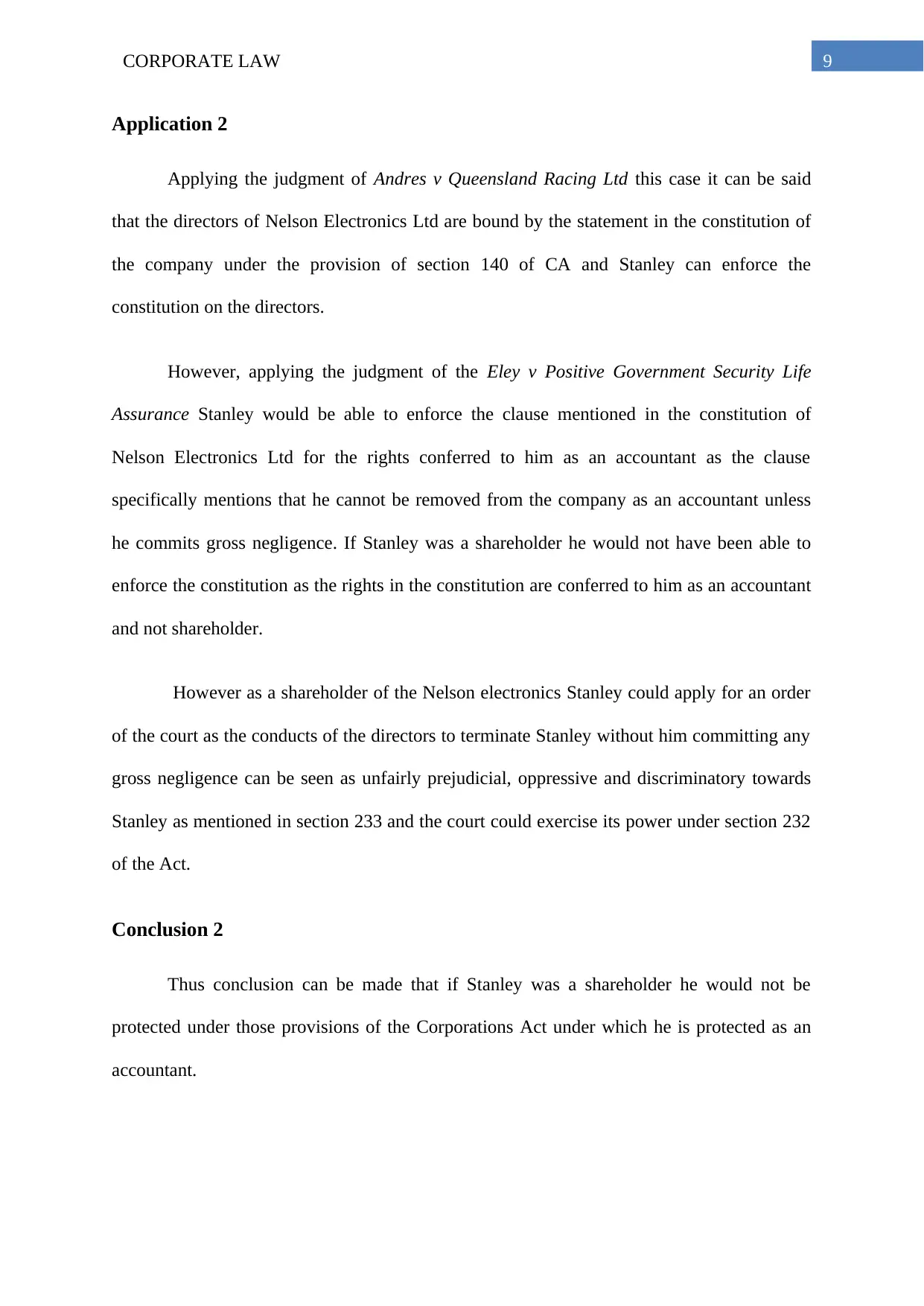
9CORPORATE LAW
Application 2
Applying the judgment of Andres v Queensland Racing Ltd this case it can be said
that the directors of Nelson Electronics Ltd are bound by the statement in the constitution of
the company under the provision of section 140 of CA and Stanley can enforce the
constitution on the directors.
However, applying the judgment of the Eley v Positive Government Security Life
Assurance Stanley would be able to enforce the clause mentioned in the constitution of
Nelson Electronics Ltd for the rights conferred to him as an accountant as the clause
specifically mentions that he cannot be removed from the company as an accountant unless
he commits gross negligence. If Stanley was a shareholder he would not have been able to
enforce the constitution as the rights in the constitution are conferred to him as an accountant
and not shareholder.
However as a shareholder of the Nelson electronics Stanley could apply for an order
of the court as the conducts of the directors to terminate Stanley without him committing any
gross negligence can be seen as unfairly prejudicial, oppressive and discriminatory towards
Stanley as mentioned in section 233 and the court could exercise its power under section 232
of the Act.
Conclusion 2
Thus conclusion can be made that if Stanley was a shareholder he would not be
protected under those provisions of the Corporations Act under which he is protected as an
accountant.
Application 2
Applying the judgment of Andres v Queensland Racing Ltd this case it can be said
that the directors of Nelson Electronics Ltd are bound by the statement in the constitution of
the company under the provision of section 140 of CA and Stanley can enforce the
constitution on the directors.
However, applying the judgment of the Eley v Positive Government Security Life
Assurance Stanley would be able to enforce the clause mentioned in the constitution of
Nelson Electronics Ltd for the rights conferred to him as an accountant as the clause
specifically mentions that he cannot be removed from the company as an accountant unless
he commits gross negligence. If Stanley was a shareholder he would not have been able to
enforce the constitution as the rights in the constitution are conferred to him as an accountant
and not shareholder.
However as a shareholder of the Nelson electronics Stanley could apply for an order
of the court as the conducts of the directors to terminate Stanley without him committing any
gross negligence can be seen as unfairly prejudicial, oppressive and discriminatory towards
Stanley as mentioned in section 233 and the court could exercise its power under section 232
of the Act.
Conclusion 2
Thus conclusion can be made that if Stanley was a shareholder he would not be
protected under those provisions of the Corporations Act under which he is protected as an
accountant.
Paraphrase This Document
Need a fresh take? Get an instant paraphrase of this document with our AI Paraphraser
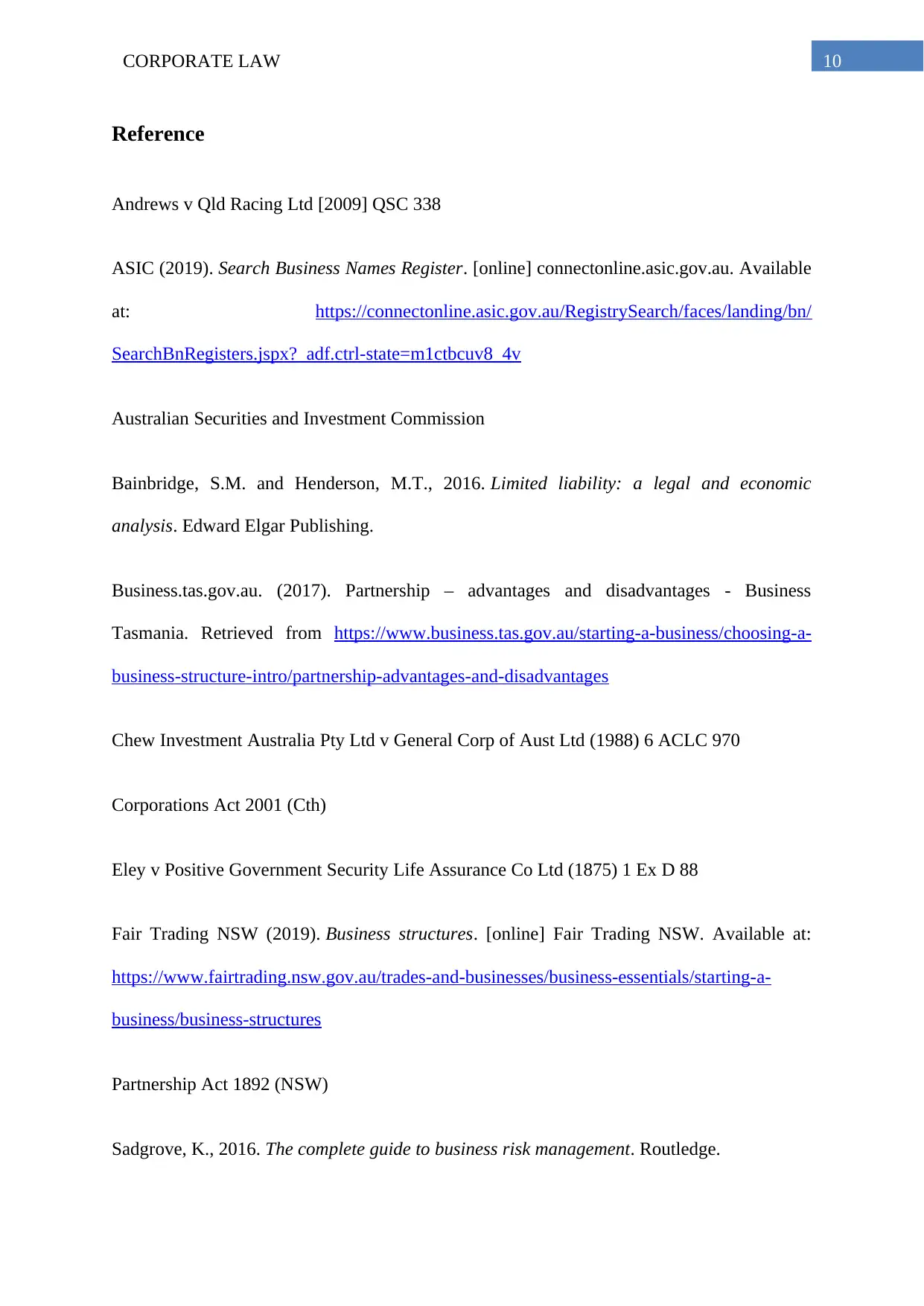
10CORPORATE LAW
Reference
Andrews v Qld Racing Ltd [2009] QSC 338
ASIC (2019). Search Business Names Register. [online] connectonline.asic.gov.au. Available
at: https://connectonline.asic.gov.au/RegistrySearch/faces/landing/bn/
SearchBnRegisters.jspx?_adf.ctrl-state=m1ctbcuv8_4v
Australian Securities and Investment Commission
Bainbridge, S.M. and Henderson, M.T., 2016. Limited liability: a legal and economic
analysis. Edward Elgar Publishing.
Business.tas.gov.au. (2017). Partnership – advantages and disadvantages - Business
Tasmania. Retrieved from https://www.business.tas.gov.au/starting-a-business/choosing-a-
business-structure-intro/partnership-advantages-and-disadvantages
Chew Investment Australia Pty Ltd v General Corp of Aust Ltd (1988) 6 ACLC 970
Corporations Act 2001 (Cth)
Eley v Positive Government Security Life Assurance Co Ltd (1875) 1 Ex D 88
Fair Trading NSW (2019). Business structures. [online] Fair Trading NSW. Available at:
https://www.fairtrading.nsw.gov.au/trades-and-businesses/business-essentials/starting-a-
business/business-structures
Partnership Act 1892 (NSW)
Sadgrove, K., 2016. The complete guide to business risk management. Routledge.
Reference
Andrews v Qld Racing Ltd [2009] QSC 338
ASIC (2019). Search Business Names Register. [online] connectonline.asic.gov.au. Available
at: https://connectonline.asic.gov.au/RegistrySearch/faces/landing/bn/
SearchBnRegisters.jspx?_adf.ctrl-state=m1ctbcuv8_4v
Australian Securities and Investment Commission
Bainbridge, S.M. and Henderson, M.T., 2016. Limited liability: a legal and economic
analysis. Edward Elgar Publishing.
Business.tas.gov.au. (2017). Partnership – advantages and disadvantages - Business
Tasmania. Retrieved from https://www.business.tas.gov.au/starting-a-business/choosing-a-
business-structure-intro/partnership-advantages-and-disadvantages
Chew Investment Australia Pty Ltd v General Corp of Aust Ltd (1988) 6 ACLC 970
Corporations Act 2001 (Cth)
Eley v Positive Government Security Life Assurance Co Ltd (1875) 1 Ex D 88
Fair Trading NSW (2019). Business structures. [online] Fair Trading NSW. Available at:
https://www.fairtrading.nsw.gov.au/trades-and-businesses/business-essentials/starting-a-
business/business-structures
Partnership Act 1892 (NSW)
Sadgrove, K., 2016. The complete guide to business risk management. Routledge.

11CORPORATE LAW
Salomon v A Salomon & Co Ltd [1896] UKHL 1, [1897] AC 22
Salomon v A Salomon & Co Ltd [1896] UKHL 1, [1897] AC 22
⊘ This is a preview!⊘
Do you want full access?
Subscribe today to unlock all pages.

Trusted by 1+ million students worldwide
1 out of 13
Related Documents
Your All-in-One AI-Powered Toolkit for Academic Success.
+13062052269
info@desklib.com
Available 24*7 on WhatsApp / Email
![[object Object]](/_next/static/media/star-bottom.7253800d.svg)
Unlock your academic potential
Copyright © 2020–2025 A2Z Services. All Rights Reserved. Developed and managed by ZUCOL.





